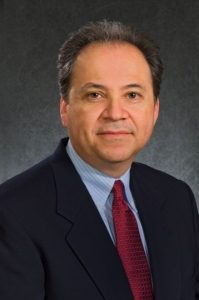Working with residents gives ABR volunteer Ronald Arellano, MD, opportunities to pass along knowledge he has gained as a clinical interventional radiologist and educator.
It also provides Dr. Arellano, who serves as program director for interventional radiology at Massachusetts General Hospital, with chances to learn from his trainees. One especially valuable lesson came from a resident in his program.
“One of our residents always had his computer open, working on things between cases,” he said. “We did a complex biopsy, and after it was done, I turned to him and said, ‘We should write this up as a case report.’ That was on a Wednesday. By Friday, he had a manuscript for me. By Saturday, I had edited it. We submitted it Saturday night and it was accepted on Sunday.”

A wealth of knowledge has made Dr. Arellano an excellent ABR volunteer. He was a question writer from 2019 to 2022 and has been an oral examiner for the past six years.
AJ Gunn, MD, was a trainee under Dr. Arellano and volunteers with him as an oral examiner. Dr. Gunn, a faculty member at the University of Alabama at Birmingham’s Radiology Department, said his former program director is always willing to help.
“Dr. Arellano is a patient and dedicated educator who has impacted the lives of many trainees during his career,” he said. “It is no surprise that he has taken the time to volunteer with the American Board of Radiology to broaden his impact and service to those outside his institution. As a volunteer on our oral certifying exam committee for interventional radiology, he was one of the most active and consistent members of the group and greatly contributed to the team’s success.”
Dr. Arellano started his training at the University of California San Diego with the goal of becoming a surgeon. He changed his mind based on his background as a radiology technician and a curiosity about where the field could take him.
“As interesting and good as (surgery) was, I felt that I would be more multidimensional as a radiologist,” he said.
He then faced another choice: Did he want to take the diagnostic or interventional radiology route? He was interested in imaging but the lure of more patient contact and the opportunity to perform procedures was too strong.
“I felt comfortable in the procedure rooms working with needles, guide wires, and catheters,” Dr. Arellano said. “Even though I liked abdominal imaging a lot, I decided to go with what felt right.”
To round out his training, Dr. Arellano completed fellowships at UC San Diego Medical Center in cardiovascular and interventional radiology and at Massachusetts General Hospital in abdominal imaging.
“I was able to get the best of both worlds and it’s been a gratifying and rewarding career,” he said.
Dr. Arellano has been amazed by the progress he has seen over his career as an interventional radiologist. Duties that were once tedious and more risky have become routine and much less invasive thanks to innovations in the field.
“I think about the TIPS procedure that we often do in interventional radiology,” he said. “When I was an intern in surgery, I was holding retractors for six hours while the surgeon was creating the changes in the flow dynamics that we now do in an hour or an hour and a half through a needle puncture in the neck.”
He sees even more marked progress coming in the next decade.
“It’s going to become even more refined, more sophisticated, less invasive, but with a powerful impact on patient care,” he said.
Dr. Arellano splits his weeks between clinical work and procedures with a little time for administrative tasks. His commitments, including volunteering for several associations and societies, are more manageable thanks to the education he received from watching the resident working on his laptop between cases.
“Between cases, while I’m waiting for a patient to be prepped or draped or waiting for anesthesia to get set up, I have my computer with me,” he said. “I tend to things during the day so that I can free up my evenings and my weekends. Our resident taught me the value of efficiency.”


